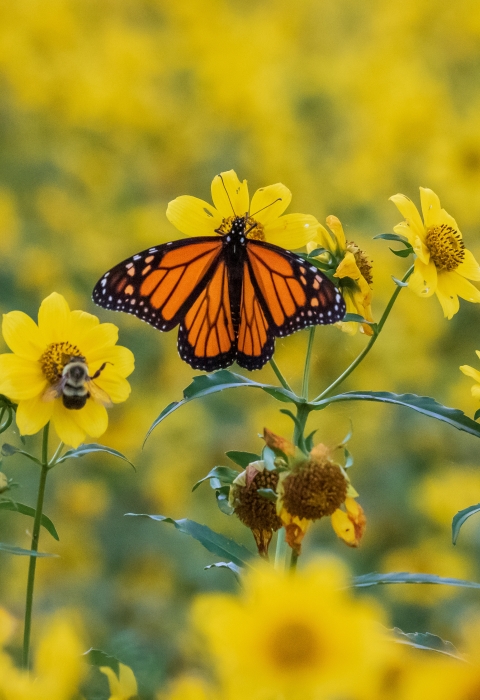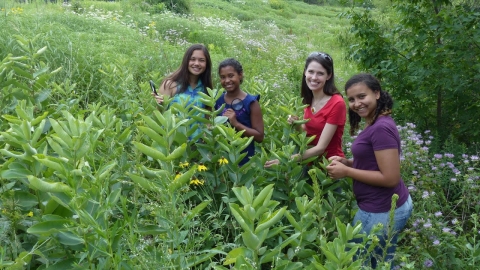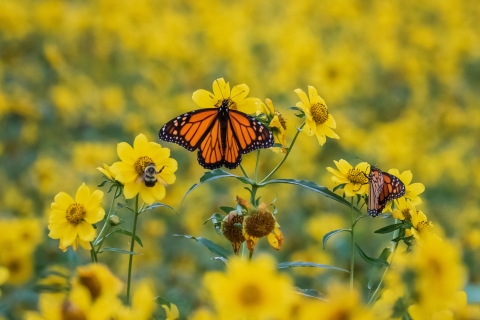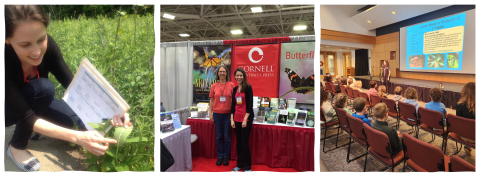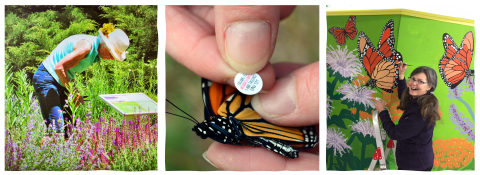Making a Difference for Monarchs
Kelly Nail is a fish and wildlife biologist dedicated to protecting pollinators and to education outreach. Kelly grew up in Minnesota, summer home to the majestic monarch butterfly. They are one of the few butterfly species that migrate long distances north and south like birds. Kelly is so passionate about them; she even won a crop art blue ribbon at the Minnesota State Fair for decorating her hard-earned graduation cap with monarchs!
With its iconic orange and black markings, the monarch butterfly is one of the most recognizable butterfly species in North America and is known for its impressive long-distance migration. Monarchs are important for many reasons! They may not be as good of pollinators as bees, but they are a flagship species for conservation. This means that monarchs are well-known and charismatic, so people are more likely to get involved in working to protect them. By promoting habitat restoration for monarchs, other pollinators and wildlife species are also benefiting.
Kelly studied at St. Olaf College in Minnesota where she double majored in mathematics and biology. It was in college while working on several different projects when Kelly really became passionate about research and publishing her studies. After she graduated from college, Kelly earned her teaching license and taught biology, anatomy and physiology, and forensic science at a public high school in Greenville, Mississippi.
While she enjoyed teaching and the outreach aspect of her work, Kelly wanted to go back to school to focus on conservation. That pursuit is what led her to the Monarch Lab at the University of Minnesota, where she earned a Ph. D. in conservation biology under her advisor, Dr. Karen Oberhauser. Kelly shared with excitement, “Monarch butterflies are not only a species in need of conservation, but also a species that is well known and loved by the public. While at the Monarch Lab, in addition to research and teaching, I was able to do a lot of outreach.” She has worked with monarch butterflies in the classroom, testified before a Minnesota House of Representatives committee on pollinator conservation, and filmed an episode of the PBS Kid’s show SciGirls, to encourage girls in STEM. Kelly also co-edited a book on monarch research titled, Monarchs in a Changing World: Biology and Conservation of an Iconic Butterfly.
In 2014, Kelly started her career with the U.S. Fish and Wildlife Service (Service) as a biologist and pathways intern in the Minnesota Wisconsin Field Office. The Pathways Internship Program is not just an internship, it’s a career opportunity that allowed Kelly to see the many options the Service has to offer. During this time, Kelly worked on the conservation of imperiled species, such as Poweshiek skipperling and Higgins eye freshwater mussels. She said, “I was hooked, and started as a full-time biologist once I finished grad school in 2016.”
A few years later, Kelly took on a new role as project manager for the Species Assessment Team (SAT), and currently works at the Midwest Regional Office in Bloomington, Minnesota. She leads teams across the country in compiling the best available information on species to help inform listing decisions under the Endangered Species Act (ESA). Kelly has been involved with the Service’s work on monarch butterflies for many years, including the monarch species status assessment (SSA) team. “I am incredibly lucky to work with teams of very dedicated biologists, all committed to conservation and upholding the mission of the Service. My favorite part of what I do is knowing that we are providing protections for the species that need it the most,” Kelly explains.
Each winter, the eastern North American monarch population has been surveyed starting in December when monarchs are clustered together. Counting individual monarchs in these sites is challenging, so researchers estimate the population by measuring the area they occupy in hectares. Each hectare (about 2.5 acres) contains somewhere around 21.1 million monarchs (according to Thogmartin et al., 2017). When Kelly started her research on eastern monarchs, their population numbers had just gone below two hectares for the first time since starting standardized monitoring in the 1990s. The monarch population dropped below two hectares three more times during Kelly’s time in graduate school. The primary drivers affecting the health of the two North American migratory populations are changes in breeding, migratory, and overwintering habitat due to conversion of grasslands to agriculture, urban development, widespread use of herbicides, effects of climate change climate change
Climate change includes both global warming driven by human-induced emissions of greenhouse gases and the resulting large-scale shifts in weather patterns. Though there have been previous periods of climatic change, since the mid-20th century humans have had an unprecedented impact on Earth's climate system and caused change on a global scale.
Learn more about climate change , etc. The eastern monarch population overwintering numbers for the 2023–2024 winter were just announced as 0.9 hectares of monarch-occupied forest. Currently, the population size remains low, driving continued concern for the migration and increased conservation action. These major dips in population make conservation work on monarch butterflies all the more important!
In her research, Kelly focused on the impacts of changing temperatures on monarchs, and the differing migration strategies the species employs. She has investigated immature monarch survival, trends in egg and caterpillar survival, and estimated the average amount of milkweed planted that results in one adult butterfly (which is just over 28 milkweeds, but with lots of caveats).
In a recent article titled, Butterflies Across the Globe: A Synthesis of the Current Status and Characteristics of Monarch (Danaus plexippus) Populations Worldwide, Kelly and her fellow Service colleagues, Lara Drizd and Kristen Voorhies (now with the Field Museum), provide a review of the locations and information available on monarchs throughout the world. Through another study projecting future impacts, Kelly and colleagues, including Service coworker Jennifer Szymanski, modeled monarch population responses to multiple drivers (i.e., amount of available breeding and overwintering habitat, insecticide use, migration resource availability, and climate change). Her research has been used as the Service analyzes the monarch using the SSA framework, which then informs the evaluation of the monarch butterfly for listing under the ESA.
In addition to seeing her published work play a small role in informing monarch conservation, Kelly has found it really meaningful to see her efforts inform other data-poor butterfly species conservation. To learn more, check out her other research.
How You Can Help
Citizen science data regularly informs her research. Kelly said, “Citizen, or community, science is such an exciting field, where the general public helps collect data in collaboration with scientists, which allows much broader data collection than would ever be possible by one person.” Monarch Joint Venture is partnered with the U.S. Fish and Wildlife Service as well as other federal and state agencies, non-governmental organizations working together to protect monarch migration across the United States. They have many citizen science opportunities and other resources to help you get involved and play a role in monarch conservation.
Other ways to get involved include creating habitat and pollinator gardens for monarch butterflies and other pollinators. Consider growing locally native varieties of milkweed, which is the required host plant for caterpillars of the monarch butterfly and thus play a critical role in the monarch's life cycle. In order to get the energy required to breed, migrate, and build reserves for the winter adult monarch butterflies depend on nectar-rich plants. Flowers like goldenrod, coneflower, black-eyed Susan, aster, bee balm, ironweed, and sunflowers are loaded with rich nectar. Lastly, pesticide-free gardening is a great approach that not only helps the insects and critters in your yard, but it’s healthier for you too. To learn more about monarch butterflies, check out the species profile page.
Brought to you by the USFWS Library
The USFWS Library serves the Fish and Wildlife Service community to support research, learning, and science excellence. We are connecting USFWS scientists to library resources worldwide via library.fws.gov. The FWS Scholar series highlights Service employees in the field who have contributed to scientific research and the work of conservation. If you are a USFWS employee who has recently published peer-reviewed scientific literature and would like to share your research with others, email us at library@fws.gov.
